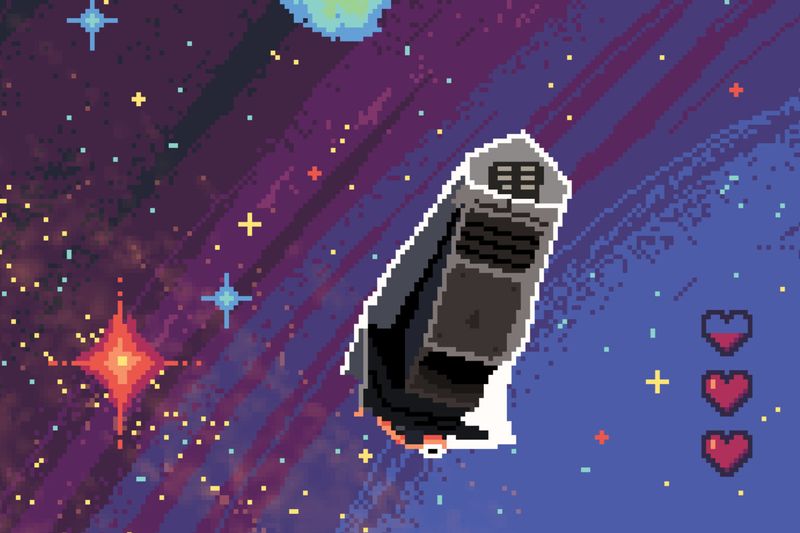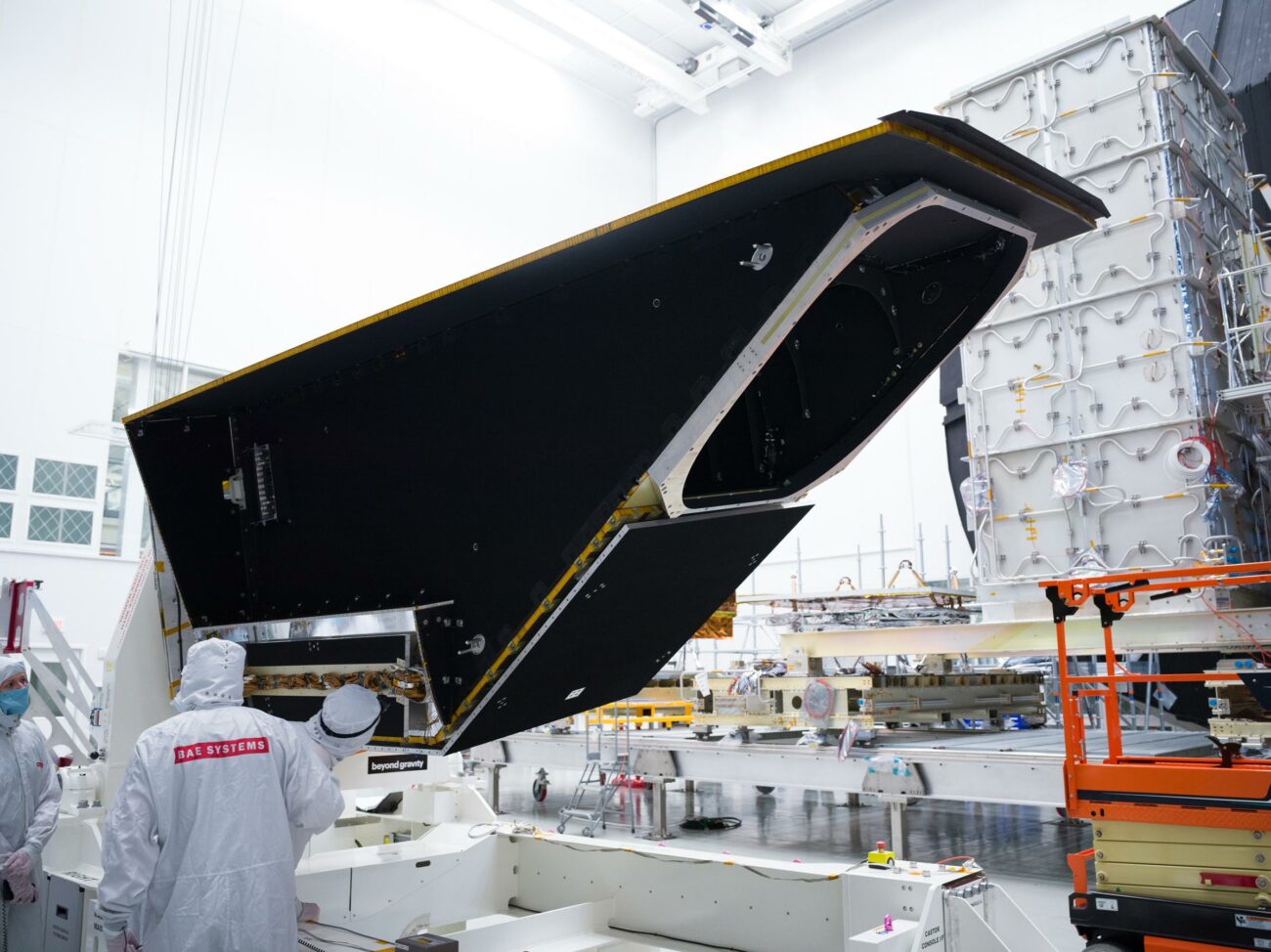
Utah State Magazine, written by Eric Warren. Illustrations by Liz Stanger.
Hollywood is obsessed with space.
From Armageddon to Deep Impact to Don’t Look Up, these movies about world-ending doom entertain us and also, potentially, leave behind a kernel of concern in our psyche.
While these blockbuster films are works of fiction, space is incomprehensibly vast, and there are countless objects orbiting the sun, from icy comets to rocky asteroids. Some of these objects do present a unique danger to Earth. One only needs to look at the moon’s craters and ask where they came from.
A specific class of objects called near-Earth objects, or NEOs, are of particular interest to observers because their orbits bring them into proximity to our planet.
While most NEOs do not pose a risk, their potential for catastrophic impacts — such as the one that wiped out the dinosaurs and 90 percent of life on Earth 65 million years ago — has prompted extensive efforts to hunt for and monitor these objects. Characterizing and tracking NEOs is an important element of planetary defense, and NASA is on the leading edge of this global effort.
In 2009, NASA launched the Wide-field Infrared Survey Explorer, known as WISE, which was an infrared astronomical space telescope designed to survey the full sky. Although the mission’s primary objectives were not to find asteroids, it turned out to be unexpectedly capable in this area, finding tens of thousands of new solar system objects.
This mission and the subsequent NEOWISE program marked significant steps forward in providing insights on previously unknown asteroids. These projects have raised the bar in technology used to detect, track, and characterize NEOs, providing data to help scientists predict with more accuracy the trajectory of potential risks and to develop possible mitigation strategies.
As NASA moves toward the launch of the NEO Surveyor telescope in late 2027, its efforts will build on the successes of predecessor missions like WISE and NEOWISE to advance the understanding of risks posed by NEOs.
And Utah State University is in the middle of it all.
USU’s Space Dynamics Laboratory is a critical collaborator in these missions. SDL’s expertise in space-based infrared sensors and thermal management technologies, along with instrument assembly, integration, and testing, played an integral role in mission success for WISE and NEOWISE.
Working closely with NASA and its Jet Propulsion Laboratory, SDL delivers technologies to enable scientists to discover and study new objects zipping through our solar system and beyond while evaluating potential risks to our home planet.
A Pioneering Survey
NASA’s WISE mission was designed to map the entire sky in infrared wavelengths, providing exceptionally detailed imagery of the known — and unknown — universe. This was the most detailed infrared survey in history. The WISE spacecraft’s only payload was an advanced infrared telescope sensitive enough to detect faint objects far outside the reach of conventional optical telescopes.
By systematically scanning the sky repeatedly in infrared, WISE created a massive data set containing more than 740 million astronomical objects, including the most luminous galaxy in the universe at 350 trillion times the luminosity of the Sun.
Astronomers also discovered the first “Trojan” asteroid that shares Earth’s orbit around the sun. These asteroids are unique because they stay at a near-stable point, hiding in a leading or trailing position relative to our planet in its predictable orbit.
Overall, WISE confirmed infrared surveys are a powerful method for finding objects wandering through space that may pose a risk to Earth. As the mission concluded its primary objectives in 2011, NASA put WISE into hibernation mode.
Despite an uncertain future, the spacecraft’s contributions were far from over.
The Rebirth
In 2013, NASA woke up WISE for a new, dedicated mission — to hunt for unknown asteroids and other objects traveling through space. That decision marked a profound turning point in NEO study. Renamed NEOWISE, the mission leveraged two of the four infrared sensors on the spacecraft to track and characterize NEOs.
By the time NEOWISE finished its mission in July 2024, it had detected over 44,000 objects in our solar system during the reactivation mission alone, significantly expanding our knowledge about the physical properties of these asteroids. Among the objects detected were roughly 3,000 NEOs, and NEOWISE provided scientists fresh data to measure their sizes and reflectivities. Among the 3,000 NEOs detected, 70 are now categorized as potentially hazardous asteroids. As a subclass of NEOs, PHAs have the potential to make threateningly close approaches to Earth.
In addition to its work with NEOs, NEOWISE provided scientists with another view of comet composition and behavior. In March 2020, Comet NEOWISE was discovered and named after the telescope that found it. The comet was discovered just months before it became visible to the naked eye and captivated skywatchers worldwide with its long tail and bright nucleus. It was one of the most widely observed comets of the 21st century, and NEOWISE’s infrared observations greatly enhanced scientists’ understanding about comets.
SDL’s Role
The success of both WISE and NEOWISE is attributable to several institutions, including important contributions from SDL, which designed, built, tested, and calibrated the WISE instrument. Following payload delivery and launch, SDL also provided mission operations support.
The foundation of WISE’s success was its sophisticated design and robust testing. Its telescope featured a 40-centimeter aperture and used 13 precision-crafted mirrors, coated in gold, that enhanced infrared reflection. Four advanced infrared detectors captured images in different wavelengths, enabling scientists to identify and characterize objects in space with remarkable detail.
To function properly, the instrument had to be kept extremely cold — near absolute zero — so its heat emissions would not interfere with its observations. This was achieved using a cryostat, a sophisticated cooling system filled with frozen hydrogen. Even after the coolant ran out, WISE could operate at reduced sensitivity, allowing it to continue discoveries under NEOWISE.
In addition to managing thermal properties, SDL developed the spacecraft’s instrument electronics, enabling the capture of high-resolution infrared images while in orbit. The information gathered was key to creating the images used by scientists to identify and characterize NEOs and other objects.
Pedro Sevilla (’88 B.A., ’90 M.S.), an SDL distinguished engineer and scientist, worked on the WISE and NEOWISE programs from their beginnings.
“For two decades, it’s been a privilege for SDL to play such an important role in designing, testing, and powering the science behind these missions,” Sevilla says. “There’s a thrill in seeing new discoveries unfold in scientific papers almost daily — it’s a testament to the work we’ve done and a promise that the impact will continue in the decades ahead.”
After nearly 15 years of an originally planned seven-month mission, the WISE/NEOWISE telescope re-entered Earth’s atmosphere and burned up, as expected, on November 1, 2024.
Next Steps
While NEOWISE made improvements to detecting NEOs, much work remains to be done.
SDL is helping UCLA and NASA’s JPL to build the next-generation asteroid-hunting telescope to further improve our ability to find and assess NEOs. NEO Surveyor, which is planned for launch in late 2027, will be the most advanced space-based telescope explicitly built for NEO detection and characterization. The state-of-the-art infrared telescope will provide the clearest pictures of NEOs to date, significantly enhancing our understanding of the potential risks these objects may present.
NEO Surveyor’s main objective is to help NASA advance progress toward the agency’s goal of identifying 90 percent of NEOs larger than 140 meters (460 feet) in diameter and characterize their orbits. With dedicated technologies for asteroid hunting, NEO Surveyor will be able to detect NEOs at greater distances than prior missions.
SDL is contributing multiple vital optical, electrical, and thermal subsystems to the NEO Surveyor instrument, and conducting environmental testing for the Optical Telescope Assembly developed by JPL. The SDL subsystems include the design, fabrication, and testing of the focal plane electronics housing. This housing protects the sensitive electronics responsible for capturing and processing images. SDL will also develop the camera enclosure assembly.
In addition, SDL will build and test the central electronics unit — essentially the instrument’s brain. This unit handles instrument operation, processes imagery data, and monitors important housekeeping tasks to validate systems are functioning as expected. The SDL team will also produce all the necessary instrument cabling, as well as the two flight focal plane modules, which are the mosaic of sensors that convert infrared light into data.
Brent Carlsen (’88 B.S., ’02 M.B.A.), SDL’s NEO Surveyor program manager, underscored the mission’s significance.
“At SDL, we’re proud to build on our WISE and NEOWISE legacy by delivering cutting-edge technology for NEO Surveyor,” he says. “This mission isn’t just about spotting asteroids — it’s about giving humanity the tools to understand and prepare for what’s out there.”
Once these instrument components are completed, SDL’s final role is to assemble, test, and calibrate the entire 8-by-14-foot NEO Surveyor instrument at its facility on USU’s Innovation Campus.
SDL has expanded its facilities and capabilities to meet the spacecraft’s needs during its extended stay, including renovation of multiple building high bays, upgrading crane capacities, procurement of a new, very large thermal vacuum chamber, and development of a new multi-infrared calibrator for NEO Surveyor’s assembly and testing prior to launch.
One of the most important aspects of readying NEO Surveyor for space is testing its performance in conditions replicating the extreme space environment. The new massive thermal vacuum chamber is a specialized enclosure designed to simulate the vacuum of space and the temperature extremes that a spacecraft experiences (as low as negative 321 degrees Fahrenheit). Light sources will also be introduced into the chamber to test and calibrate NEO Surveyor’s sensitive instrumentation.
These new additions to SDL’s facilities are integral to ensuring NEO Surveyor is ready to meet the challenges of planetary defense and asteroid detection.
“With every component we design and test, we’re helping to ensure that if something big is headed toward Earth, we’re giving mission planners clarity and time to act,” Carlsen says.
NASA’s asteroid-hunting missions have evolved and represent a substantial achievement in humanity’s ability to detect, track, and characterize NEOs. SDL’s expertise in infrared systems, spacecraft technologies, thermal management, and instrument assembly, integration, and test has been an important component of mission success for these programs.
With SDL’s help, even objects in space as small as a house will have a harder time slipping past unnoticed.

This article was originally published in the Spring 2025 issue of the Utah State Magazine. To read more about Utah State and SDL’s impact, visit www.utahstatemagazine.usu.edu.